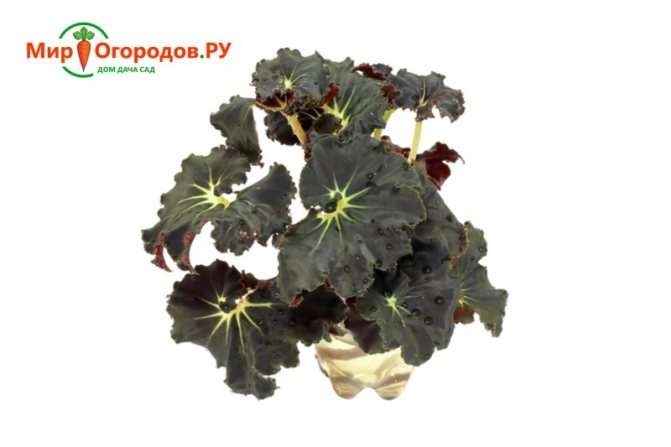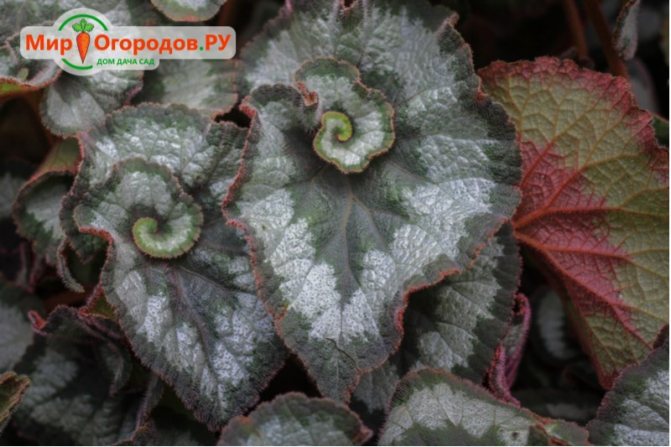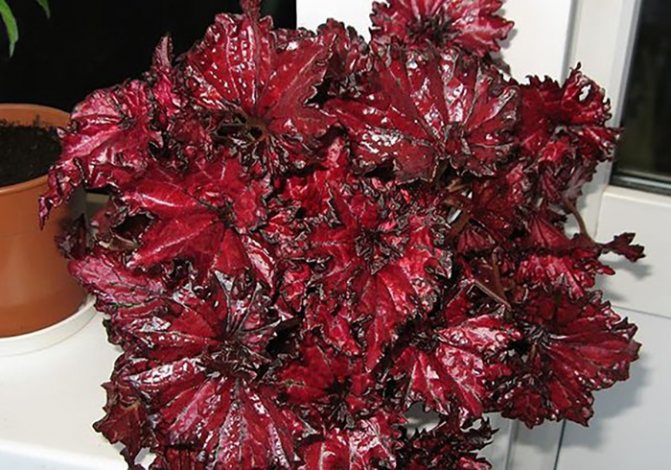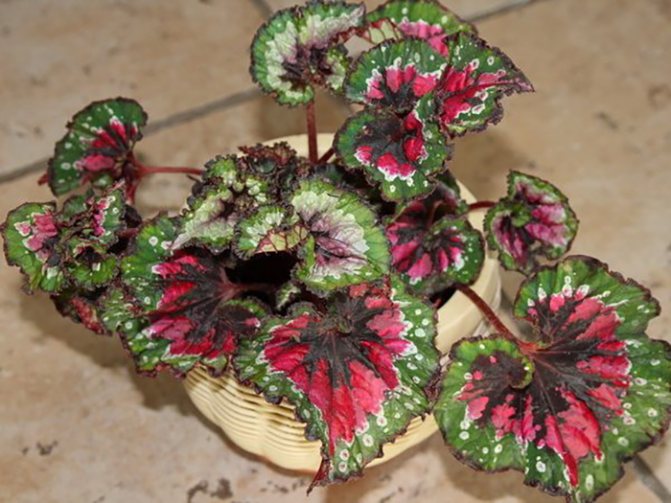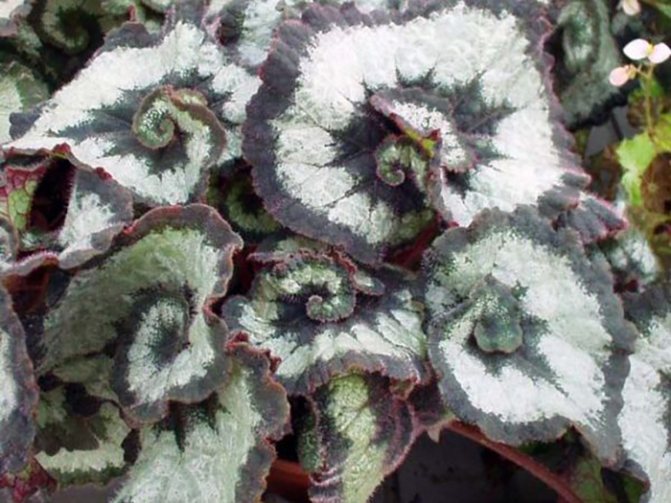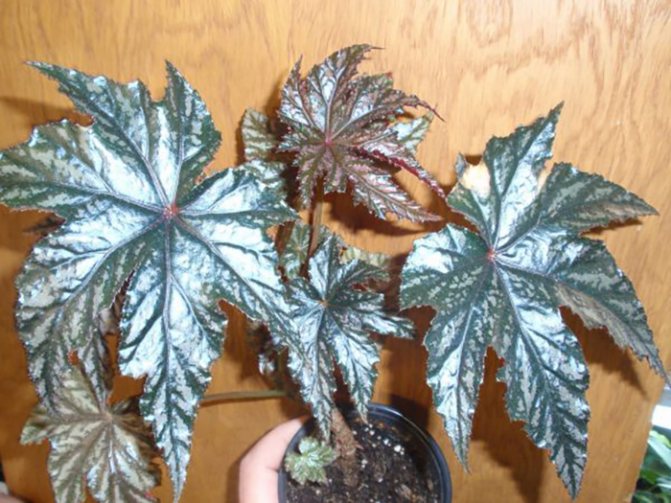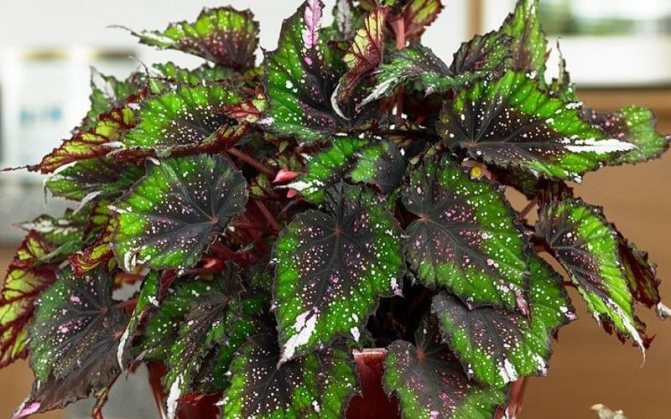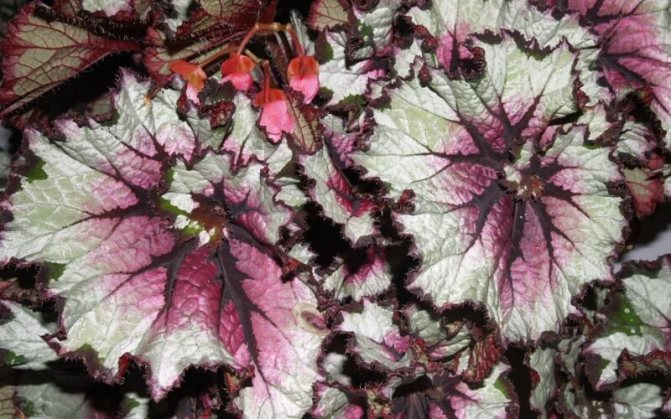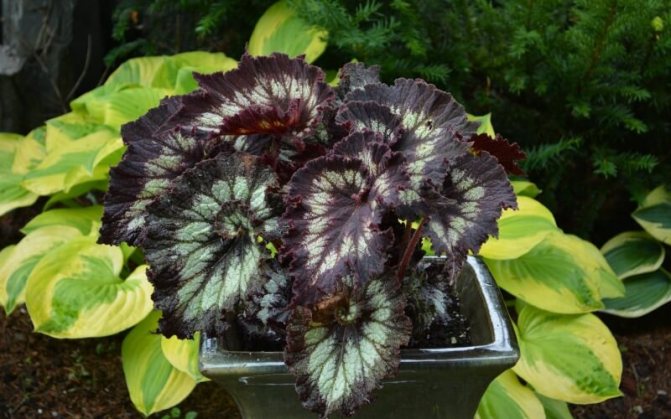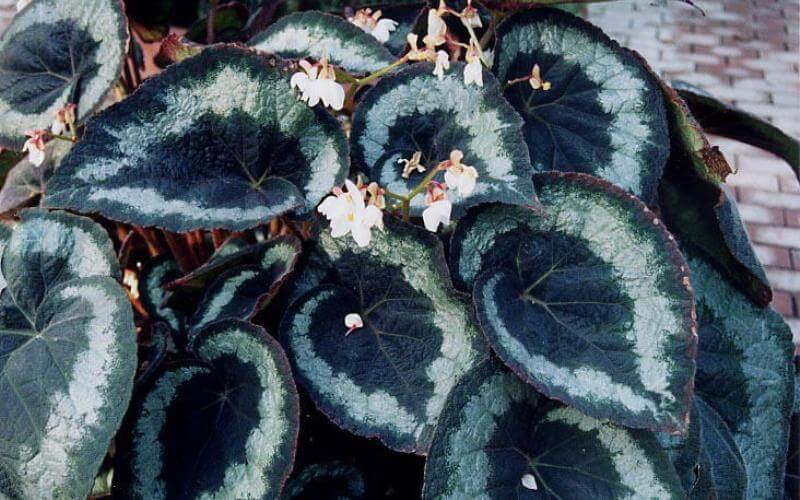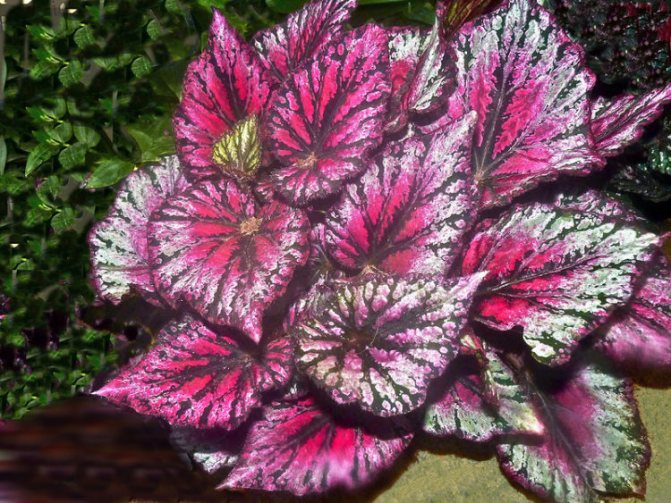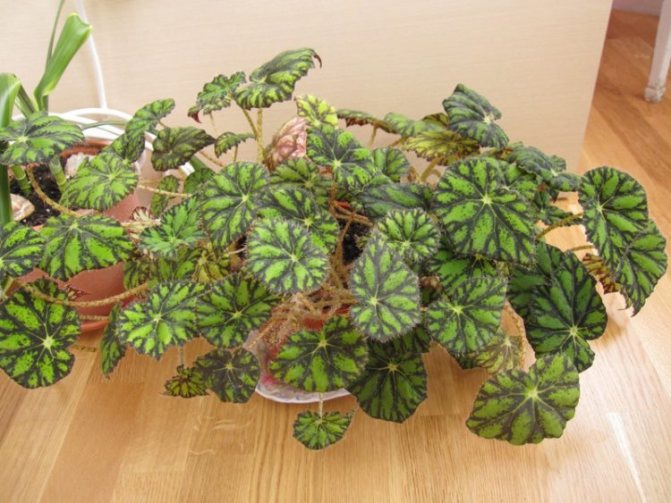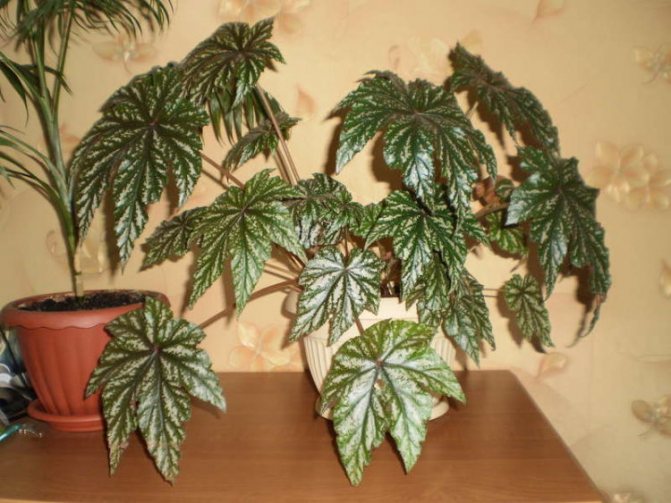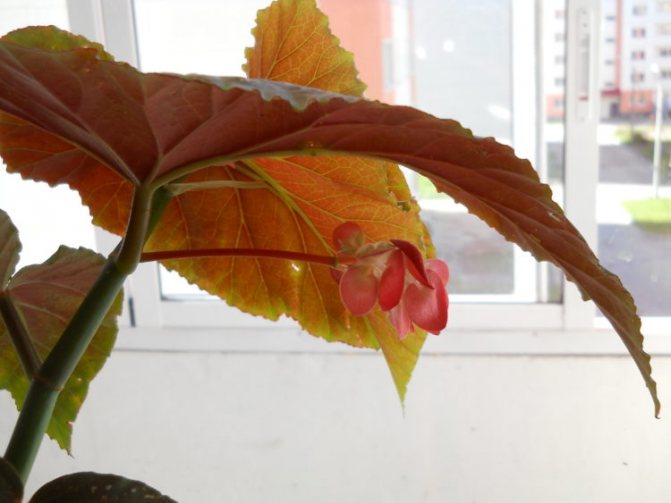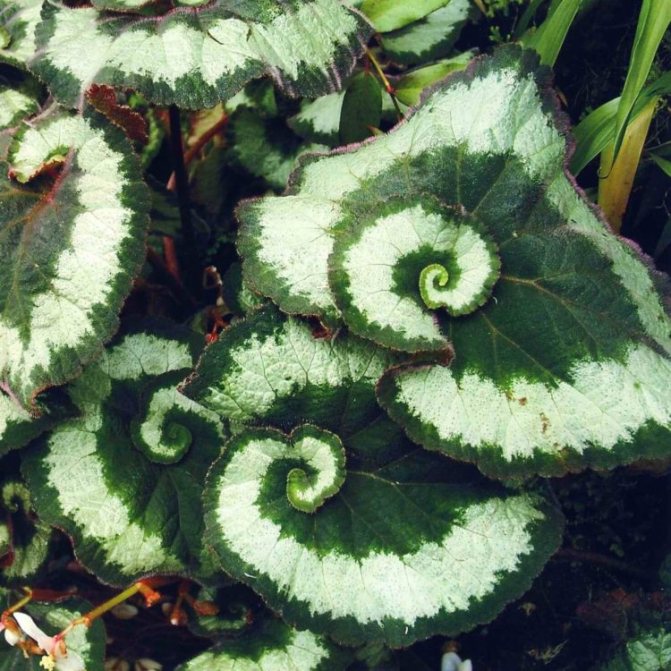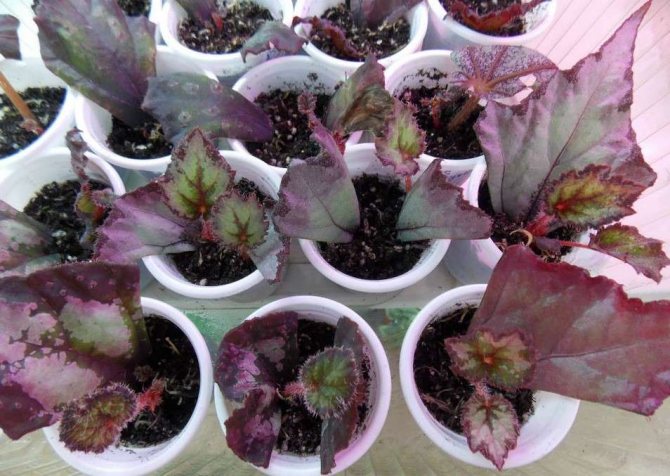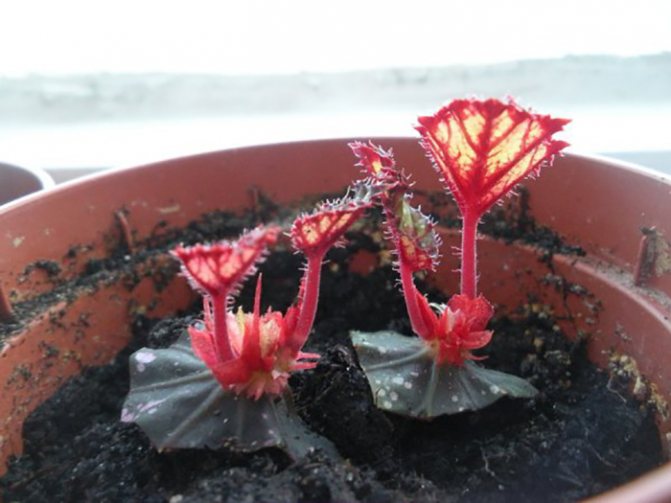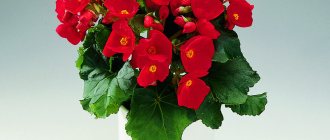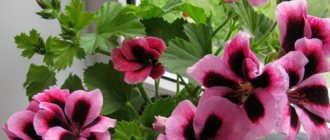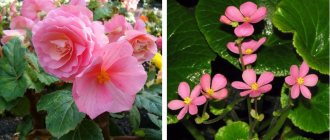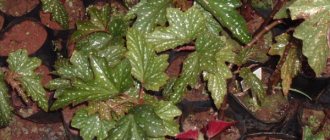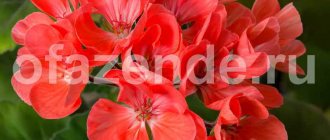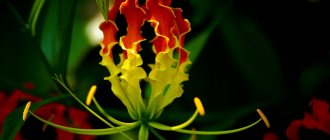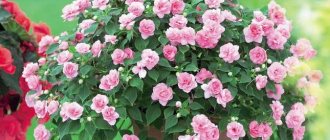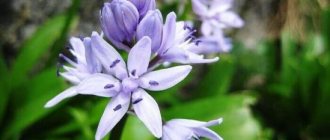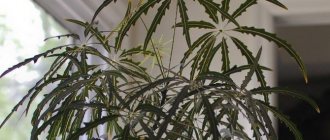Most of us have indoor flowers at home that we love to care for. Plants dilute the interior, add color and positive energy. Everyone has their own indoor flowers, but sometimes you want to add something new. Only now, in order for the plants to grow and develop well, you need to know about their preferences and care. After all, some flowers grow in neutral soil, like shading and occasional watering, some sunny windowsill, alkali in the soil and a lot of moisture. Today we decided to tell you all about caring for one of the most beautiful home flowers and this is Rex begonia.
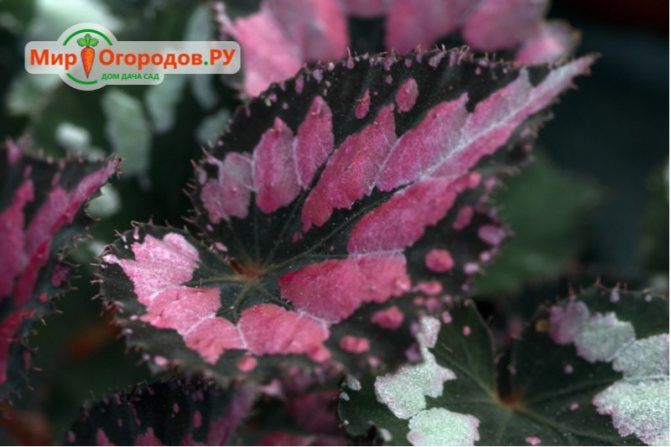
Unique colors of begonia
Exotic beauty
The plant deservedly bears the name "royal". Its luxurious large leaves with jagged edges and long stems stand out for their bright color. Depending on the variety, it may have blotches of raspberry, red, silver or purple stripes. They resemble elephant ears or a slightly distorted heart in shape.
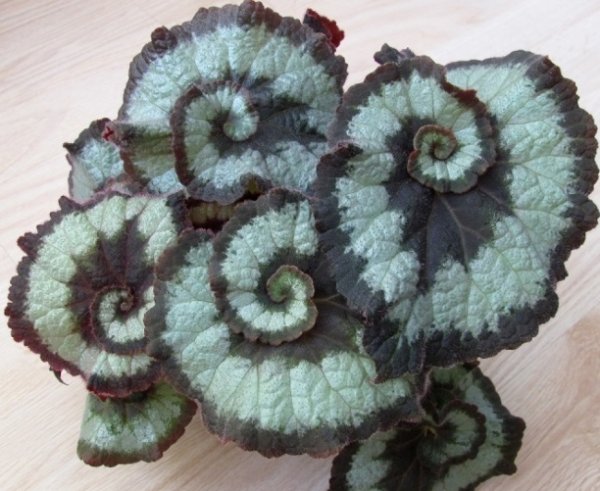

Begonia royal
Important! Begonia bushes grow up to forty centimeters in length, and the height of mini-shrubs of this species is no more than fifteen.
Rejuvenation and reproduction methods
The tropical beauty Rex is not a long-lived perennial. After 2-3 years, the bush loses its compactness and falls apart. To preserve the decorative properties, the plant is regularly updated, or a new one is grown to replace the old one.
Royal begonia prefers vegetative propagation - by leaf cuttings or by dividing the rhizome.
Rooting a fragment of a leaf
A large leaf plate is divided into segments so that each has a thick vein that will give a baby. The soil for planting is taken loose, moistened in advance, poured into a transparent cup. A leaf is planted here, placed in a greenhouse. For this purpose, any plastic container is suitable, for example, for things. The frequency of ventilation depends on the volume of air in the greenhouse.
As soon as a new sprout appears, it is taken out of the greenhouse and grown like a regular indoor flower.
Popular varieties
Tiger begonia - growing and care at home
Among the variety of varieties of Royal begonias, the most popular and widespread begonia are Escargot, Griffin, Dark Mambo and Mary Christmas.
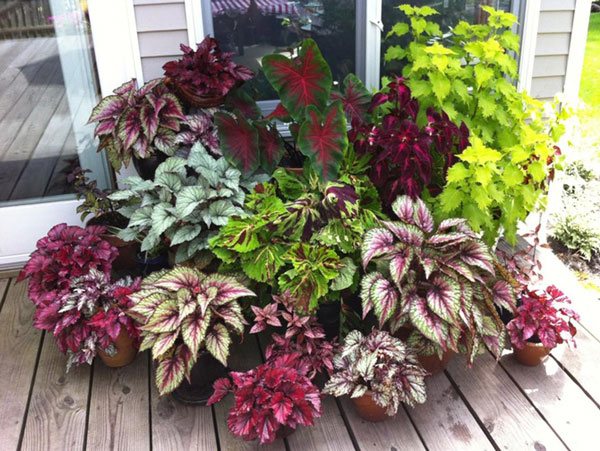

Types of royal begonias
Escargot. The spirally curled leaves with a silvery line in the middle resemble a seashell.
Griffin. Large foliage with a carved border is painted in pink and green.
Dark Mambo (dark mambo begonia). The color of the leaves is olive and dark olive. The center of each plate is decorated with a star-shaped spot.
Mary Christmas. The variegated foliage of this plant has the brightest combination of colors in color - from bright pink to green and brown. At the edges, the color becomes burgundy.
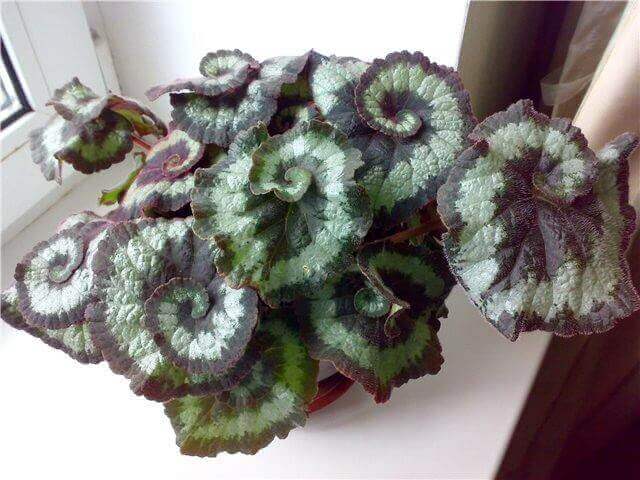

Begonia Escargot
Main varieties and their description
Royal begonia is distinguished by its characteristic features, thanks to which the flower can be distinguished among many indoor plants. Despite the high resistance of the species to all kinds of changes, in recent decades, several dozen successful varieties have been created by breeders, which brought him tremendous popularization.
General characteristics of royal begonia:
| Characteristic | Description |
| Root system | Powerful, creeping, branched. |
| Stem | Fleshy, branched, about 10–20 cm in length. Covered with short reddish bristles. |
| Leaf shape | Asymmetric, on the one hand, a characteristic sharpening develops, the edges of the leaflets are serrated. Depending on the species, the shape of the leaf blade can vary from cordate to spiral or difficult to dissect. |
| Leaf color | Most often, green color predominates with various inclusions of scarlet, crimson, lilac, purple and gray shades. The veins of the leaves have a contrasting red tint. |
| Flower shape | Rounded, with fan-shaped petals. |
| Flower color | The species blooms in all shades of pink or pale pink. |
class = "table-bordered">
Mini merry christmas
This begonia is a short plant, reaching a length of 30 cm. It is one of the most variegated varieties in existence. A characteristic feature of the variety is a change in the shade of the leaves from the center to the periphery (from darker tones to lighter ones).
The central part of the leaf is a brown shade, which turns to red-crimson to the edges, and then to green-white. The lower part of the leaf blade is pronounced sinewy, with large veins, the upper part is velvety, soft to the touch.
Escargot
Escargot is one of the largest of its kind. This flower reaches a height of 30 cm, while its width can reach 40–45 cm. The surface of the plant is dull, it is characterized by numerous villi.
Leaves are the main advantage of the Escargo variety. They are characterized by a swirling spiral shape, as well as a rich silvery-green hue.
Did you know? Royal begonia was first discovered in 1856 in the state of Assam (India).
Dark mambo
One of the more exotic varieties in plant growing is the Dark Mambo begonia. Its distinctive feature is a rare, almost black shade of the outside of the foliage. Sometimes it can be lightened by greenish inclusions, but always the leaf has a rather dark color.
The inner side of the foliage is red-brown or brown-cherry in color. The plant is of medium size (about 30 cm in height) and has a swirling, spiral-shaped leaf blade.
Grifon
Begonia Griffin is a fairly tall plant with a height of about 40–45 cm. It is one of the few varieties that can be successfully grown in pots as a perennial plant and in a flower bed as seasonal vegetation. The flower leaves are large enough, divided into separate pointed areas.
Their color is of all kinds of green tones, with bright grayish patterns all over the surface. The flower is unpretentious, so it can be successfully grown even by novice growers.
Dollar down
This variety is famous for its rich and bright red-cherry shade of foliage and compact size of the bush (the flower does not exceed 20-25 cm in height). The edges of the leaves have a dark, almost black border, which gives them a special contrast.
The shape of the leaf blade is often asymmetrical, fan-shaped, its size gradually increases from the center to the outer borders.
Did you know? Begonias were named after the Governor of Haiti, Michel Begon, who, being a lover of exotic flora, donated a lot to an expedition to India to find new plants.
The healing effect of the plant
Begonia Royal has a number of qualities beneficial to human health:
- can be used as an antiseptic for the healing of abrasions, scratches;
- reduces motor activity and smooth muscle tone in order to suppress muscle spasm.
Begonia - home care, cultivation
Begonia extract is a part of medicines to stimulate blood circulation.Begonia-based preparations treat burns and ulcers.
Additional Information! Royal begonia has a beneficial effect on the indoor climate, neutralizes the damaging effect of synthetic materials (plastic, synthetic winterizer). The leaves of the plant reduce the number of staphylococcus bacteria in the air.
Royal begonia:
The beginning of the history of the flower is considered to be the beginning of the 18th century, when English plant hunters went to Bolivia and Peru in search of new species. The name of the flower comes from the name of Governor Michel Begon. Now the family of begonias includes 1000 traditional species and several, 1000 hybrids. The classic look of Rex begonias is the most common disguise, large pubescent leaves, with a red silver pattern, the flower needed to adapt to life in the twilight of the tropical jungle. The large, patterned leaves of Rex begonia come in a wide variety of colors and shapes, and they are all incredibly beautiful and exotic.
Begonia appearance, photo of begonia.
Its appearance is very diverse, even herbaceous plants vary in size from tiny to very large, with creeping or tuberous thickened rhizomes.
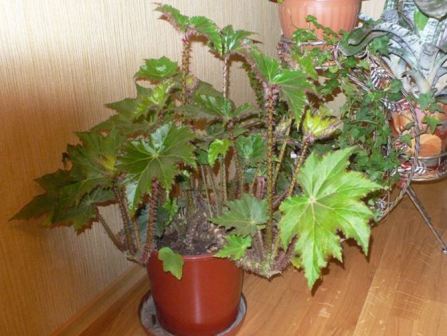

Royal begonia photos
Reproduction of begonias.
A distinctive feature of begonia is its unusually developed ability for vegetative reproduction. They can easily propagate by leaf and stem cuttings, rhizomes, and even parts of a leaf. In the royal begonia, the trunk does not exist in the usual sense, it is located on the surface, on the ground in a pot. When transplanting, it can be divided into two pots by dividing the trunk, this is done only when the plant is very large.
In order for us to get young plants from the roots of begonia, they separate a piece of the roots during transplantation and place them in a light substrate. After a certain period of time, shoots of plants will sprout at the root planting site.
Begonia care.
Royal begonia is very thermophilic, but at the same time it is difficult to tolerate dry air. Begonia is not whimsical to care for, because its foliage is fleshy, during growing begonia sometimes requires drying an earthen lump, and in no case ever overmoistening. Because the root system can rot. If the soil in the pot does not dry out, it is best to just loosen it a little, one loosening replaces one watering.
Begonia transplant:
To transplant begonia, we take an empty pot, put expanded clay on its bottom, we need a looser and lighter soil, it is laid on top of expanded clay.
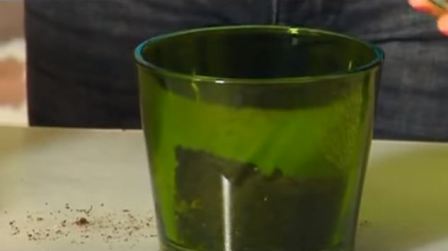

Now we take out the plant from the pot, gently press on the pot, while holding it with our hand.
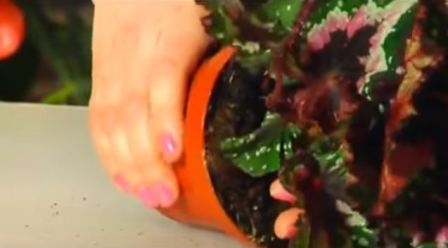

The root system of begonia is very fragile, very thin, it can be damaged during transplantation, so this must be done very carefully, without breaking the lump, we transplant it into a new pot.


And add new soil.
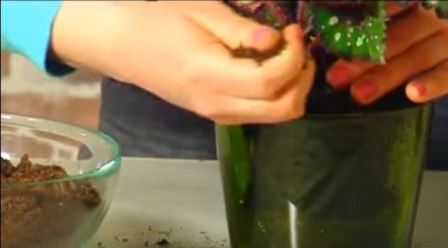

We compact the earth so that there is no air space between the root system and the pot, we compact, but not strongly, so that when watering, the water penetrates evenly.
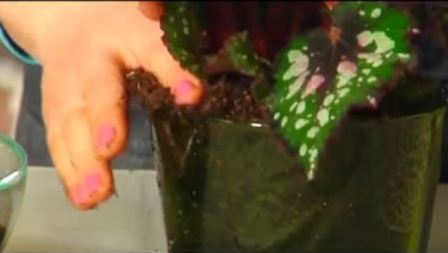

Watering begonias:
Water the begonia directly under the root, it is undesirable for the water to fall on the foliage.
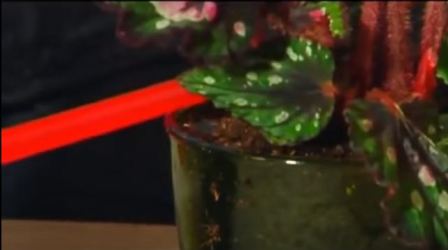

Begonia loves a lot of diffused light, in winter the temperature should not drop below + 18C, in the summer the temperature in the room should be about + 20C .. + 22C, avoid drafts.
Video tips - royal begonia
Begonia royal home care will not take you much effort or time, the main thing is to observe the temperature regime and water it correctly. Read more articles about indoor plants, we have a lot of interesting and useful information that we will be happy to share with you, dear readers. On this we say goodbye to you, wish you success and all the best, see you soon on the farmer's website without any hassle!
How royal begonia came to be
Ever-flowering begonia - cultivation and care
This marvelous flower was found on Indian soil in 1856. The find immediately attracted the interest of breeders from different countries. The flowers, taken from the usual subtropical and tropical climate, were first planted exclusively in greenhouses, creating suitable conditions. Over the years, specialists in plant breeding and improvement have created a variety that is more resistant to an unusual atmosphere. Thanks to this transformation, begonias were kept indoors in pots on window sills and flower stands for houseplants. She even began to decorate garden beds and flower beds.
Growing problems
Royal begonias are highly susceptible to fungal diseases (eg root rot, gray mold), which can also be caused by over-watering and wetting the leaves. They can sometimes also be threatened by pests (such as spider mites), which must be disposed of with an appropriate insecticide. Plants are also susceptible to light. Too dry air dries out the ends of the leaves, and from too sunny a place, the plant will get burns and ugly spots on the leaves.
Features of caring for a flower at home
Royal begonia can be called an unpretentious domestic soil dweller. Even a novice florist can take care of her. A few simple recommendations will help with this.
Temperature regime
The air in a room with flowers of this type should not get very hot. Let's say the range is fifteen to twenty degrees. Overheating and through wind can destroy the plant.
From late spring to the onset of autumn, begonia is taken out into the open air (balcony, terrace).
Lighting
Sunlight and access to it is necessary for the bright color and color saturation of the foliage. He must act in a balanced way. An overabundance threatens the appearance of burns on the deciduous plate, and their twisting. Weak lighting will deprive the plant of its tone and elasticity.
Watering
Water is the main source of food for the flower. The main thing is moderation. Watering is necessary when the top layer of the earth in the container dries up. The liquid should not sit in the sump.
Humidity level
To maintain moisture, a container with water is left next to the flower pot. Large begonia leaves are wiped with a cotton pad moistened with settled water.
Soil selection
It is necessary to prepare the soil or choose a ready-made mixture for planting very carefully. It affects the quality of flower nutrition and the formation of the root system. The roots of this plant are weak. Therefore, we need a loose (water and oxygen permeable), nutritious soil. The mixture should include:
- deciduous humus;
- peat mass;
- vegetable humus;
- sand.
A drain is placed at the bottom of the pot to control soil moisture.
Important! It is necessary to choose leaf humus without tannins. They increase the acidity in the soil.
Nutrients
Begonia Royal is fed once or twice a month. Fertilizer with potassium and phosphorus in the composition is suitable. These substances contribute to the early maturation and strengthening of plants.
Bloom
Begonia Rex amazes with the catchy and enchanting appearance of its leaves. And the flowers during the flowering period will not make an impression. They are pale and small in appearance. Consist of several petals. Florists often remove the buds of flowers so as not to deprive the plant of additional nutrition.
From the end of autumn to March, the flower plunges into a state of dormancy, ceasing to bloom. During this period, caring for the Royal Begonia is minimized. Watering is reduced to once a week.
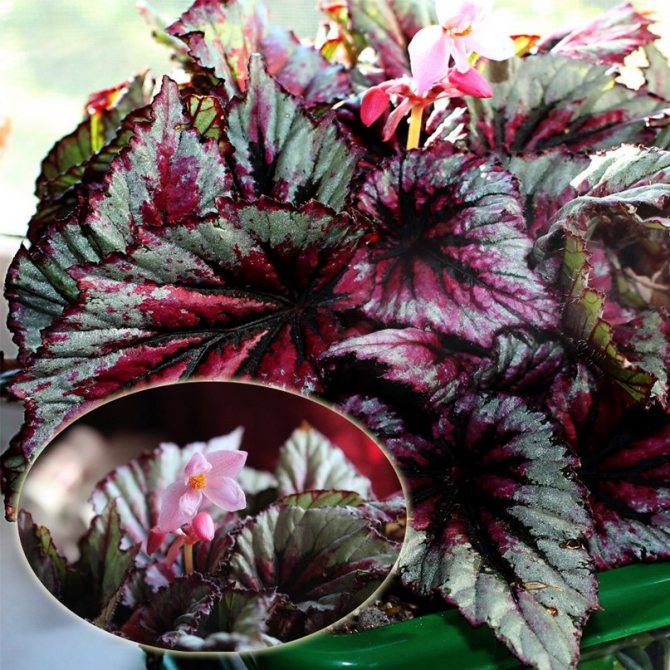

Flowering of royal begonia
Royal begonia, or regal Begonia rex and its hybrids
ROYAL BEGONIA (Begonia rex Pulz). Family Begoniaceae. Homeland - Southeast Asia.
The division of plants into decorative-leaved and flowering plants is very arbitrary, because almost all of them bloom in places of natural growth.In indoor conditions, they are considered decorative-leaved, since for various reasons they do not bloom, and if they do bloom, they have nondescript flowers. They are appreciated primarily for their unusual and very beautiful leaves.
- Classification of begonias into groups
- Group of ornamental begonias
- How to properly care for begonia
A large role of ornamental-leaved plants in the large family of begonias (Begoniaceae) is assigned to the royal, or regal (B. rex) begonias, and when classified, it is often singled out in a separate group, and not placed in the group "Rhizomatous - rhizome, rhizome begonias", although Rex Begonias - are typical rhizome begonias.
Royal begonia (Begonia rex Pulz) is a perennial bushy herb with a thick creeping stem. A low stem emerges from the creeping rhizome. The leaves are large on juicy reddish petioles, beautiful variegated, oblique with an oblique base. From above, the leaf resembles crumpled velvet, and from below it has veins sharply protruding and the plate itself resembles a stretched membrane. The leaf blade and its petiole are covered with red hairs.
In 1856, royal begonia was discovered at an auction in London among Asian orchids, and already in 1859 three new forms were found. After that, intensive work began on the development of new forms and varieties. The material for crossing was mainly Asian species - b. yellow (Begonia x anthina), Begonia diadema, Begonia cathayana (Cathay), Begonia robusta (powerful) and some others.
Over the entire period of the history of breeding royal begonias, numerous varieties of them were bred, differing in various colors and shapes of leaves with long, oval, pointed, wide, with purple, silvery, bluish and pink stripes, specks, blotches. The varieties with zonal colored leaves look spectacular, in which the leaf colors change from green or green-silver to maroon. Many of them are decorated with irregular white spots or strokes.
Some of them bloom, but royal begonia flowers are not very decorative, so it is better not to allow flowering. Flowers are small white or pink, collected in drooping racemes. It is better to cut them off so that the plant does not deplete and the leaves get more nutrition. The leaves of this plant are the main decorative value.
Begonia rex hybrids belongs to the hybrids of the royal begonia, it is an ornamental-deciduous compact plant, 10-25 cm in size, which has an ornamental appearance throughout the year. Its inflorescences are inconspicuous, not very large, white or pale pink, has heart-shaped or broadly oval leaves, with jagged edges, of various colors (purple, pink, silvery, red, green).
New hybrid of royal begonia - Griffin (Gryphon Begonia hybrida). Has large decorative leaves. This begonia is quite large, hardy plant up to 41 cm in height and width. More undemanding to watering and more versatile, it can be used as a permanent pot culture, as well as for a garden with partial shade during the growing season. The majestic beauty of the royal begonia of the Griffin hybrid combines useful and practical properties. This powerful, long-lasting houseplant can be used to accentuate conservatories, and in summer it can be combined with other begonias in large containers ...
Reproduction
Royal begonias have several breeding methods:
- seeds. The sowing period is from September to January. The seeds are superficially immersed in containers with soil, sprayed with water and covered with foil. The seedlings are regularly ventilated. After the emergence of sprouts, the containers are removed to a lighted cool place;
- cuttings. Shoots of ten to fifteen centimeters with several leaves are cut from the main plant. The leaves are shortened by a third and, after the slices have dried, the cuttings are immersed in a liquid that stimulates growth.Then they are planted in the ground;
- separation of roots. The flower is carefully removed from the pot. The roots are washed, after which they are divided into several parts so that each of them remains with a shoot or bud. After processing the sections with an antiseptic, all segments are placed in separate containers with prepared soil;
- sheet. A large leaf without signs of disease is divided into several parts. Then all parts are planted at an angle into a mixture of volcanic rock with humus of marsh plants, and covered with polyethylene. Rooting takes place within thirty days;
- air layering. The trunk is cut obliquely to the middle of the thickness. A plastic or wooden plate is inserted into the incision so that re-fusion does not occur. The incision is closed with a plastic bag and secured on both sides. The roots will appear in about a month.
Botanical description
Royal begonia is directly related to the family of begonias. Another name for this variety is Rex. Among the people, the royal begonia received the nickname "frostbitten ear" or "Napoleon's ear", it was in 1812 during the flight of French troops from Moscow. Indeed, the leaf with its outlines on the lower red side resembles a frostbitten ear.
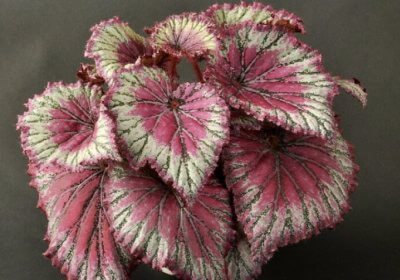

In nature, this plant can be found in the north-east of India. Height varies from 15 to 40 cm.
The flower is distinguished by asymmetrical leaves that have a beautiful pattern and unusual color. The color scheme is represented by green-brown shades with hints of silver. The shape of the leaf is also different and can be cordate, round, oval, cochlea. The edges of the leaves can be carved or wavy and only occasionally whole.
The stem of the plant is quite large, fleshy, the root system is branched and sometimes protrudes to the surface.
For all the beauty of the leaves, the flowering of the royal begonia is rather scarce and for the best growth, the inflorescences are often removed.
Transfer
Transplanting is a mandatory step in plant care. Thanks to her, rejuvenation occurs. You need to do it every three to four years. You will need a fresh soil mixture. You can cook it yourself or buy it ready-made in a specialized store. Fresh soil should include leaf and sod soil, peat mixture and sand (preferably river), in a ratio of 2: 1: 1: 1, respectively. For nourishment, you can add a little pine bark or deciduous humus.
The bottom of the container chosen for transplantation is traditionally filled with drainage.
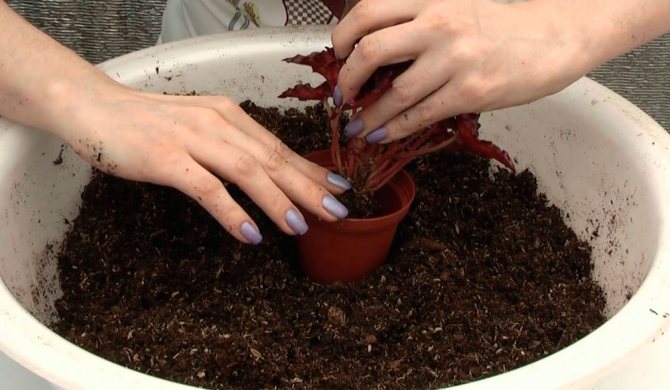

Begonia transplant
Description of the plant
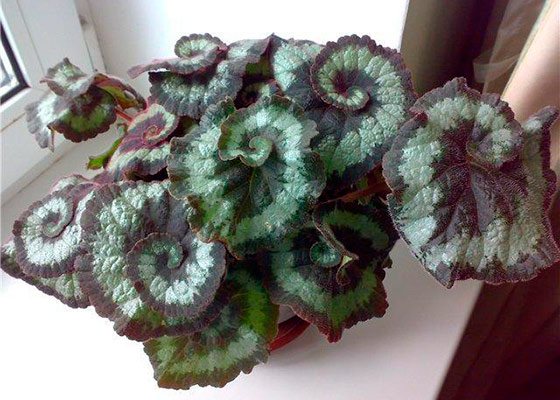

The value of this species depends on how the royal begonia looks, or rather, its foliage. Small inconspicuous flowers do not have decorative effect, in contrast to bright and beautiful leaves. They are quite large and asymmetrical, with an uneven jagged edge.
The color can be varied, but certainly very bright and attractive, which best suits the name of the variety. Colors can have inclusions of unusual shades: scarlet, lilac, crimson, purple and even silver. Veins often differ in tone from the main color.
These decorative features of the royal begonia are due to the specific needs of the plant.
- Due to the bright color and rough surface of the leaves, their temperature is increased to accelerate the evaporation of moisture. This helps to deliver more valuable nutrients to the root system.
- The asymmetrical shape of the leaf is caused by the need to receive sunlight. Due to the fact that all sheet plates are of different shapes, they do not overlap.
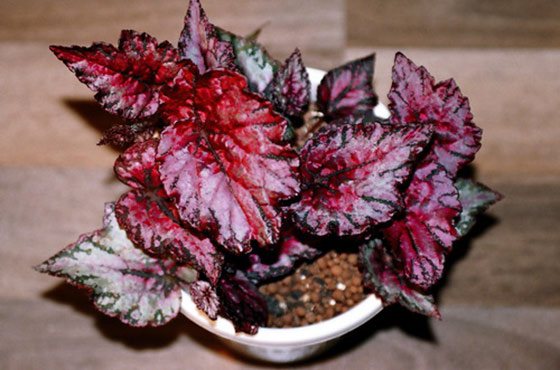

It is worth noting several aspects of how it is useful.
- Firstly, this variety has a positive effect on the respiratory system, so it is very good to keep it at home for smokers and patients with chronic bronchitis.It speeds up the treatment of throat and thyroid ailments.
- Secondly, begonia is believed to have exceptional energy. Perfect for people who host a lot of guests at home, and for creative people.
Diseases and other troubles of royal begonia
There are several diseases that affect begonia more often than others.
Gray rot. Due to excessive humidity in the air or soil, conidia and sclerotia multiply. They are the ones that cause the disease. An external sign is softened leaves.
Downy mildew - caused by a dangerous pathogenic fungus. It is also the result of waterlogging. Yellow spots are formed on the foliage.
In addition to diseases, small pests are also a threat.
Bubbles (thrips). Because of their parasitism, multi-colored spots are formed on the foliage.
Mealybug. Fallen leaves will indicate the presence of this insect.
To get rid of small parasites and the consequences of diseases, plants are treated with special solutions. In case of complications, several transplants may be necessary.
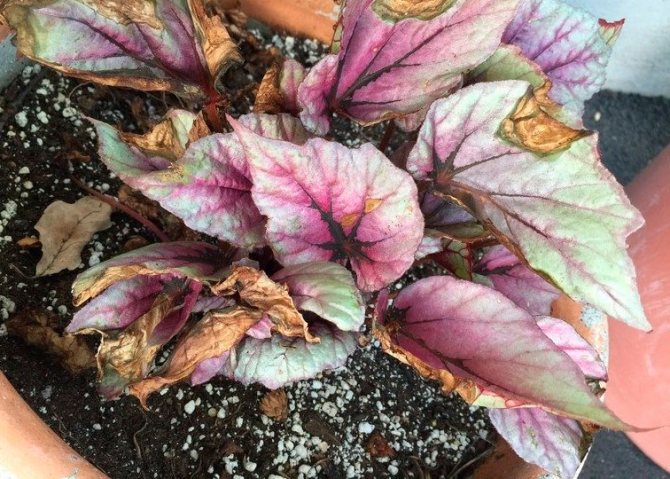

Royal begonia diseases
Among other problems in begonia care, it happens that the tips of the leaves dry out. This is due to insufficient lighting. For the same reason, foliage can turn pale. If the plant sheds the buds that have appeared, then it is too hot and needs to be moved to a cool place.
Begonia Rex: proper home care - from planting to breeding
Choosing a place
Although begonia comes from hot countries, it does not like the direct sun, which is why its leaves can lose bright shades and look dehydrated. The fact is that in tropical forests, wild plants always grow in partial shade of trees. And even if we have long ago made the Rex begonia a traditional flower for our country, you still have to provide it with partial shade or diffused light at home.
Moreover, there is another important nuance - begonia does not like turning and transferring from place to place. Tropical flowers do not bend towards the rays of the sun, they do not like their direct hit, so immediately choose a room where it will be light and a shelf that will not be in direct sun. But if it is hot here - up to 30 degrees, then this is quite normal for a flower. But still, the optimal temperature is 18-23 degrees. Begonia does not like drafts and temperature drops and stops growing.
Advice! For the winter, many experienced florists send Rex begonia to a cooler room or to an insulated balcony, where the temperature is about 14-16 degrees. But in the spring and summer, the pots can stand outside.
Humidity
In the tropics, it is warm and very humid, so flowers at home often lack water, especially in winter, when the batteries are running. At this time, you should use a moisturizer, which is also good for our lungs, skin, or place the pots on a tray. You need to put pebbles or wet cloth in it, which will evaporate the water. Watering the flowers is necessary only when the soil is almost completely dry, but do not allow the soil to peel off from the walls of the pot. In winter, flowers are rarely watered - once every 7-10 days, it is better to take settled water.
Attention! All those varieties that have fleecy leaves should not be moistened with a spray bottle, as brown spots may remain, and the decorative appearance will be lost.
Pot and soil
The next very important condition in caring for Rex begonia at home is the land in which it is planted and the capacity. Perhaps you will say that you have already bought or have been presented with a beautiful flower, but you need to replant it every year. The roots of the flower need air, they are located superficially. As you grow, you need to increase the pot, change the soil to a new fertile one. There are two options here:
- We make our own soil - fill half the pot with peat, fill the rest of the pot in equal amounts with turf soil, perlite, humus.
- We use soil from the store specifically for begonias.
Important! Before planting, it is better to spill any soil with boiling water to kill bacteria and parasites.
During transplantation, always pay attention to the condition of the roots so that there is no rot, parasites. Remove the lower leaves and part of the rhizome to rejuvenate the plant. Of course, you need to cut off those parts that show signs of decay with sterile scissors. Sprinkle the slices with charcoal.
Fertilization
Flowers need feeding, especially at the time of their active growth in spring - they can be applied every 10-14 days. Since we need to get beautiful and thick leaves from begonias, and not flowers, we can use fertilizers with a high content of nitrogen, phosphorus and potassium. The first is just responsible for the growth of green mass. In winter, Rex begonia, like many indoor flowers, needs rest, so you need to make the last complementary food around the end of October. If you transplanted a flower into a new soil, then the first feeding should be no earlier than two weeks later, but you can shed a root stimulator.
Reproduction
Your beauty has been growing for more than one month, you have learned everything perfectly about leaving, and then there is a desire to plant even more royal begonias. How can this be done? Yes, it's as easy as shelling pears. Begonia Rex can multiply by roots, cuttings, and even leaves. Let's consider all the options.
- If you need a new flower, then cut off a leaf from the begonia with sterile scissors, you can even more than one, and put it in water, which you often add and change to fresh. To speed up the process will help "Kornevin" - a stimulant. When the roots have appeared, then fill in the soil that was indicated above and plant the flowers.
- Rhizome Rex begonia can be propagated during the annual transplant. Just cut off a piece and plant in a new pot.
- To propagate a flower with leaves, you need to cut one of them, cut it into small pieces so that there are veins in each. Then put on a slightly damp nutritious soil, cover with foil. Open it every day to supply air. Soon, roots will begin to form on the leaves. Now you can plant your seedling.
Advice! For planting, take pots that are no longer deep, but wide, since the root system of the Rex begonia grows precisely in breadth.
How to transplant begonia
Royal begonias love slightly acidic soil, pH 5.0-6.0. But the main requirement for the structure of the soil is that it should be very loose, airy, rich in humus and dry out quickly, no longer than 2 days completely. Not suitable for planting Rex begonias are only garden land from the beds, and clean peat. More suitable is leafy soil in its pure form (collected under last year's leaf litter somewhere in a lime park). There may be several options for potting mixes:
- 2 parts sheet, 1 part peat, 1 part coarse river sand (or vermiculite).
- 2 parts of peat soil, 1 part of coconut substrate (from briquettes), 1 part of coarse river sand (or vermiculite), 1 part of pine bark.
- 2 parts universal soil, 1 part vermiculite, 1 part sand, 1 part pine bark.
As you can imagine, sand and vermiculite are disintegrants. Pine bark also loosens and further acidifies the soil. And even with the addition of loosening components, it is necessary to ensure that the substrate in the pot does not cake, periodically loosen it with a thin, sharp stick. And when a salt crust forms on the soil surface, it is imperative to replace the top layer of the earth and soften the water for irrigation.
Royal begonias grow well in shallow and not too spacious pots, if the pot is large, the soil will dry out for a long time - this contributes to the development of pathogenic flora and root decay. But it is better to transplant begonias annually, in fresh soil, and in the same pot, if the root system has not grown too much.
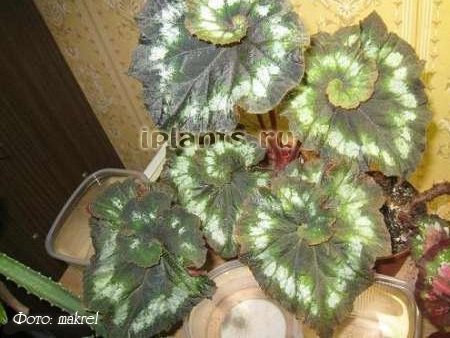

Some miniature rex begonias can be grown in wide open aquariums, in fact, all conditions for them are similar to the requirements of orchids.Also air humidity, the same requirements for light and watering, even for fertilizers and pots. When growing Rex begonias on wide trays of water, and even more so in aquariums, you can and even need (!) Use pots with drainage holes on the bottom and sides of the pot. Basically, you can grow royal begonias in wicker (plastic) baskets, or you can make holes yourself. Perhaps I will surprise someone with such recommendations, this is my personal experience, but it helps to avoid root rot, bacterial spots and other diseases. In nature, Rex begonias grow in the surface layer of the earth, which is leaf litter, branches and twigs of trees - this is a very loose substance. Many begonias are semi-epiphytic and epiphytic.
I am against adding sphagnum moss to the soil for royal begonias, as it dries for a long time, absorbing too much moisture, but you can spread wet moss between the pots to increase the humidity in the air. And against growing Rex begonias in clay pots, the soil dries out quickly enough in them, but some of the roots stick to the unglazed sides of the pot, and the hole at the bottom is usually single and small. In plastic pots, you can always slightly squeeze the sides (walls), thereby loosening and airing the soil.
What temperature does the plant need
The plant belongs to the thermophilic species, the best temperature for it is 16-20 degrees. In summer, begonia rex does not like extreme heat and drafts. If you live in a private house, then the plant can be placed on the street, and in the apartment it can be taken out onto the balcony. Fresh air has a good effect on him. There are flower growers whose plants live on balconies, in which case it needs to be insulated for the winter so that the temperature of the bull is no more than +15. Royal begonias do not need to be placed close to cold glass. The main thing is that the root system receives as much heat as the plant needs, because if this does not happen, the leaves will begin to dry out, and after such a decorative flower will recover for a very long time.

